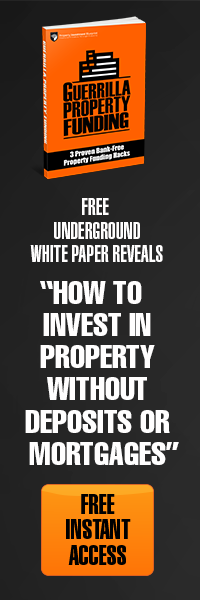
Buy To Let Bridging Loan
If you're searching for buy to let bridging loan, or a low money down mortgage, then you're in the right place.
In this article, our guest writer and mortgage broker partner, Colin, will show how an innovative new Buy To Let Bridging Loan product enables you to put down as little as 10% deposit... And speed up your portfolio building to boot. Over to you Colin!

I have recently discovered a product from a lender where the aim is to keep capital outlay at a minimum by the point of completion.
The process begins with an initial bridge loan. The product is aimed at purchase where the property requires some light refurbishment, and would ultimately improve the overall market value of the property.
Where this particularly would work is when you can purchase below current market value, carry out some light refurbishment, resulting in an increase to market value. Therefore when the BTL mortgage is put in place we can draw out extra funds to cover the cost of the bridge, refurb costs and part of the deposit.
Below is a case study with figures from an actual case to show how this can work.
Let's begin by looking at how this would work using a standard BTL mortgage, using 75% LTV, as this usually gives the widest selection in terms of lenders.
Example 1 - Regular BTL Mortgage
Market value - £65k
Purchase Price - £54k
Deposit - £13,500
Refurb Costs - £5k
Initial Outlay - £18,500
End Value - £72k
Further advance available after refurb - £13,500
Total Cost of outlay - £5k
Now, with the new product mentioned above, we start with a bridging loan for a maximum period of 6 months. The bridging loan amount is then calculated as follows: either 90% of the purchase price, or 75% of the market value, whichever produces the smaller loan amount.
So in this example, 90% of the purchase price gives a loan amount of £49,600. And 25% of the market value gives a loan amount of £48,750.
Therefore in this example, the latter would be used as it's the smaller, and the deposit would then be the difference between the loan and the purchase price: £54 - £48,750 = £6,250.
In this case, that works out at a 11.6% deposit, or a whopping 88.4% LTV. Not bad for a Buy to Let mortgage these days, right?
So now let's run the numbers again, this time using our new buy to let bridging loan:

Example 2 - Buy To Let Bridging Loan
Market Value - £65k
Purchase Price - £54k
Deposit - £6,250
Refurb costs - £5k
Initial Outlay - £11,250 (significantly less upfront leaving more liquid capital)
End Value - £72k
Mortgage value when converted to BTL - £54k
Cost of bridge and fees (£3k approx.)
Cash released - £2250
Total cost of outlay - £9k
Although the cost of outlay is greater in the 2nd example, the initial aim was for growing the portfolio with a smaller initial outlay.
Example 1 shows initial
outlay of £18,500 and example 2 shows £11,250. The costs after
initial outlay comes through the mechanics of the lend.
Furthermore, both examples rely on the end value after refurbishment which always poses an element of risk.
It can be argued that example 2 reduces this risk as both aspects of the valuation are done at the beginning, and the second visit would only be an inspection to confirm the proposed work had been carried out.
How do both examples stand up to a down value?
Let's say in this particular example the down value is £3k, meaning an end value of £69k. This would mean in example 1 we can only pull out an extra £11,250, increasing the total cost of outlay to £7,250.
In example 2, this would mean there would be no additional funds coming back and the initial outlay is the overall cost. But again, to reiterate, the initial costs were over £7,000 less.

Why is the initial outlay important if there is additional funds at the back end?
This is where there is a definite edge for example 2. All of the underwriting is done at the point of sale, so outcomes are known prior to completion and therefore less of a risk. In the case of example 1, there are more potential pitfalls in the shape of higher upfront costs.
On average, most lenders will expect the property to be mortgaged for 6 months before a further advance. They would expect significant changes to the property before considering a further advance, and the amount would be down to the valuation at the time of application.
In summation, there is a huge selection of products out there to help all property investors. The key is selecting the product that helps you achieve the goals most important to you at whatever stage your portfolio is at. This particular article and product is about maximising your available capital to increase your portfolio.
It is very important you understand all the risks fully before committing to any investment and its therefore key that you seek professional advice before proceeding.
If you'd like to know more about the buy to let bridging loan in this article, simply complete the form below and Colin will contact you for a no-obligation chat.
Enquire about this product
Complete the quick form below and Colin will contact you with more details about this product, or any other financing needs you may have:
<< Back from Buy To Let Bridging Loan to Financing Investment Property
<< Back from Buy To Let Bridging Loan to Property Investment Blueprint



